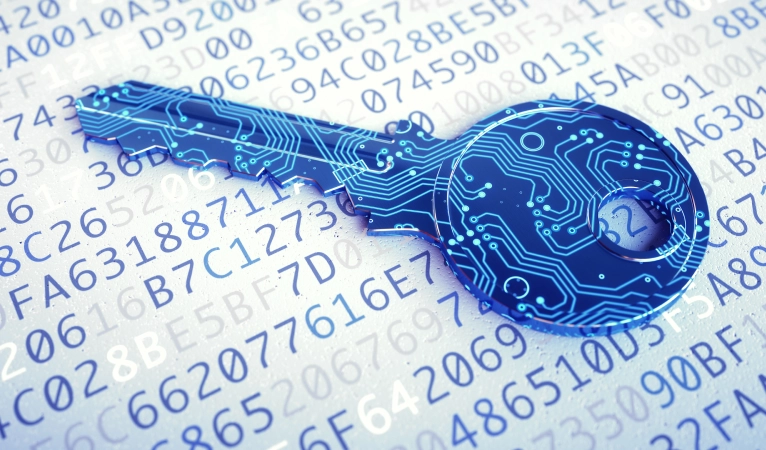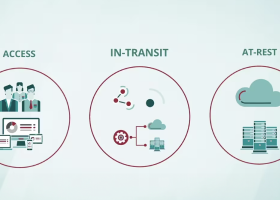Harness the Power of File Encryption
Let’s jump in and learn:
- What Is File Encryption and What Does It Mean?
- How Do Files Get Encrypted?
- What Is File Encryption Software?
- The Benefit of File Locking
- How to Choose Data Encryption Software
- What Is the Best Encryption for Files?
- What Is the Most Secure Way to Share Files?
- File Encryption Software and How It Protects Sensitive Data
- What Types of Businesses can Benefit from File Encryption?
- Most Popular Types of File Encryption to Share Data
- File Encryption for Data Security and Integrity
What Is File Encryption and What Does It Mean?
File encryption is a method of encoding data (e.g., messages or files) so that only authorized parties can read it. This prevents forgery, tampering, or theft of sensitive information while it is being stored or for encrypted file sharing. Without a key, file encryption renders data unreadable. Depending on the type of file encryption that is used, file encryption can be nearly impossible to decipher.

Any sensitive data should be encrypted as soon as it is created and remain encrypted at all times, because leaving it in plain, readable text exposes it to adversaries. The term used to describe this is end-to-end file encryption. This file encryption is applied when data is in transit (i.e., encrypted data file sharing), in use, and at rest.
Three Data States as Related to File Encryption
- Data in transit
Data in transit is being sent, shared, and transferred between users and devices through and across many channels, such as conferencing platforms, email communications, file sharing services, and social media. - Data in use
Data in use is being accessed, created, manipulated, or processed by applications. - Data at rest
Data at rest is being stored in various places, including applications, databases, mobile devices, laptops, and file servers.
How Do Files Get Encrypted?
File encryption relies on complex algorithms to encode data and create a key to decode or decrypt it. The efficacy of file encryption is determined by three factors:
- File encryption algorithm
- Length of the key used for file encryption
- Strength of the file encryption algorithm
There are two types of file encryption key systems—asymmetric and symmetric.
- Asymmetric key system for file encryption
Commonly referred to as public-private keys, an asymmetric key system uses two keys. The private key is kept secret. The public key is available to anyone that needs it. The public key and private key must be used together to decrypt data. The asymmetric key system is widely used for file encryption and encrypted file sharing. Two examples of asymmetric key systems used for file encryption and encrypted file sharing are the Rivest Shamir Adleman (RSA) and the Digital Signature Algorithm (DSA). - Symmetric key system for file encryption
Symmetric key systems are often referred to as secret key systems. With a symmetric key for file encryption and encrypted file sharing, all parties have the same key. Since a symmetric key is used to encrypt and decrypt data, it must be kept secret to ensure that the data is protected. For the parties to get the same key, there must be a way to distribute the keys securely. Examples of symmetric key systems used for file encryption and encrypted file sharing are Advanced Encryption Standard (AES), Data Encryption Standard (DES), and 3DES.
What Is File Encryption Software?
File encryption software is a type of application used to apply encryption to sensitive data to protect it at rest, in transit, and in use. Many regulations (e.g., government and industry) require the use of file encryption software to ensure the security and integrity of sensitive data. File encryption software is also widely used by organizations and individuals to protect sensitive data. A common use of file encryption software is for encrypted file sharing.
The Benefit of File Locking
- Allow others to access and edit files or folders
- Avoid data loss
- Avoid merge conflicts
- Better manage files, folders, and directories
- Improve collaboration
- Prevent conflicts while editing
- Prevent two people from opening and updating the same document or file at the same time
- See who is working on a file
How to Choose Data Encryption Software
Just as with the selection of any other technology, organizations should take time and follow a process for choosing data encryption software. In the case of file encryption solutions, the choice is of the utmost importance, as sensitive data can be put at risk if the correction solution is not selected.
A few questions to consider when choosing data encryption software are the following.
- How do vendors’ file encryption software compare?
- How sensitive is the data that the organization creates, stores, and shares?
- How will sensitive data be shared?
- Is file encryption required before files are transmitted, or can they be sent via an encrypted connection?
- What are the scalability requirements for file encryption software?
- Can the software encrypt multiple file formats?
- Can it be integrated with other software and services?
- What do user and industry reviews say about vendors’ file encryption software?
- What file encryption software capabilities would the security team like to have, but can live without?
- What file encryption software features are mandatory?
- What file encryption standards are required to support internal users and systems, customers, partners, and vendors?
- What is the organization’s budget for file encryption software?
The following are additional areas for consideration for evaluating data encryption solutions. These can help determine which type of file encryption is needed and the solution that can provide it.
Compatibility with infrastructure
It is critical that any file encryption solution be compatible with the systems and software that are already in place to avoid the time and expense required to retrofit or replace it.
Drivers for file encryption
Understand why file encryption is needed, such as ensuring robust data protection, complying with regulatory requirements, or both.
File encryption scope
Because sensitive data can be anywhere, take time to understand where it is in your organization, then confirm that the vendors being evaluated can provide file encryption for the myriad places that it could reside, such as applications, databases, mobile devices, removable media (e.g., USB flash drives or external hard drives), and servers.
Incident response plans
Most organizations have compliance requirements that require that incident response plans be in place to address a security breach. When considering file encryption vendors, be sure that they have incident response plans that meet internal and external requirements, including the ability to provide the logs needed to detect anomalies and conduct audits to limit damage and identify root causes.
Training and support
When selecting a file encryption solution, it is important to understand what training and support will be required and what resources vendors can offer to provide it if internal teams do not have the expertise or capacity. Also, understand the costs associated with training and support.
Types of threats
Determine the types of threats the organization faces, such as threats from malicious insiders, cybercriminals, or nation-states.
What Is the Best Encryption for Files?
Some of the best file encryption algorithms used for encrypted file encryption are:
- Advanced Encryption Standard (AES)—there are three lengths of AES encryption keys:
- 128-bit key length
- 192-bit key length
- 256-bit key length
- Curve25519
- Digital Signature Algorithm (DSA)
- EdDSA (Edwards curve)
- Elliptic Curve Digital Signature Algorithm (ECDSA)
- OpenPGP
- Rivest Shamir Adleman (RSA)
- Secure Shell (SSH)
What Is the Most Secure Way to Share Files?
The most secure way to share files containing sensitive data is to use file encryption or to secure the transmission.
Six Ways to Securely Share Your Sensitive Files
In addition to file encryption, six methods of secure file transmission for sensitive data are:
- Email encryption
- File Transfer Protocol (FTP)
- Near Field Communication (NFC)
- Peer to Peer (P2P) communication
- Secure File Transfer Protocol (SFTP)
- Secure Hyper Text Transfer Protocol (HTTPS)
File Encryption Software and How It Protects Sensitive Data
File encryption software is by far the best solution for protecting sensitive data. There are many ways in which file encryption ensures that sensitive data assures the integrity and security of data including supporting:
- Layered data protection—file encryption is an important one of multiple layers of security used to protect sensitive data
- Security across multiple devices—with file encryption, no matter where an encrypted is, it is protected from threats
- Secure data transfers—encrypted file sharing ensures that data in transit is protected at a very vulnerable state.
What Types of Businesses can Benefit from File Encryption?
File encryption and encrypted file sharing are used by organizations of all types and sizes that create, store, and share sensitive information. Among the types of businesses that can benefit from file encryption and encrypted file sharing are the following.
- Education—e.g., academic records, disciplinary records, and health information
- Financial services—e.g., account balances, account numbers, and credit scores
- Government—e.g., controlled unclassified information (CUI) and classified information
- Healthcare—e.g., patients’ medical records, test results, and health insurance
- Legal—e.g., client communications and documents
- Manufacturing—e.g., contract data, manufacturing processes, and materials sources
- Pharmaceuticals and biotechnology—e.g., DNA sequencing, drug formulas, and trial data
Most Popular Types of File Encryption to Share Data
There are a number of types of file encryption that can be used to share data. These include a number of file encryption software solutions that work in parallel with communication platforms (e.g., email and chat) as well as encrypted file sharing capabilities that are embedded into file encryption software.
File Encryption for Data Security and Integrity
Almost every organization has a need for file encryption. It has grown from an arcane technology used by large organizations with highly-classified or sensitive information to a must-have component of cyber security programs. With its move to the mainstream, file encryption has become much more accessible, with even the most powerful tools being accessible. Having file encryption baked into an organization’s data processes gives a leg up in fighting cyber threats.
Egnyte has experts ready to answer your questions. For more than a decade, Egnyte has helped more than 16,000 customers with millions of customers worldwide.
Last Updated: 19th January, 2024



